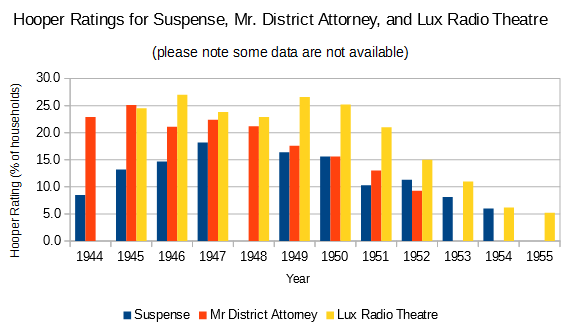Suspense was one of radio's top-rated shows with a very loyal and broad audience. How did it do compared to two other radio powerhouses, Lux Radio Theatre and Mr. District Attorney?
There's a book I have had for a long time that shows Hooper Ratings for the golden age. I just learned it is available for download https://www.americanradiohistory.com/Archive-Bookshelf/History-of-Broadcasting/A-Thirty-Year-History-of-Programs-Summers-1958-HOB.pdf
This chart shows Suspense, Mr. DA, and Lux. For some reason the 1948 rating for Suspense is not available, and it might be that the format bounced around and it had weeks where there was no broadcast. I know that in September of that year there were reports about its big ratings rebound under Auto-Lite and Tony Leader, so I might be able to make an estimate at some point. Mr. DA ratings end with the closing of the network show and the shift to syndication. It is still hard to believe for a show so big in the ratings when Jay Jostyn starred that so few of the episodes exist. Another thing you learn from the ratings was how big Dragnet was, replacing Mr. DA for many listeners. Mr. DA went to television, initially with Jostyn, and there seem to be no kinescopes of that brief series. That was the main reason it is not in the chart's later years. The book excluded syndicated programs from its ratings compilations, so the Ziv Mr. DA series is not included. The downslide in all radio ratings after about 1949 in favor of TV is fairly obvious. Compared to other series, Suspense had roughly about 2/3 of the ratings of Benny or Fibber in the mid-40s heyday.
Interpreting the chart -- this is percentage of households. During the entire period, the number of households was growing. That means that 10% of households in 1944 is a lot different than 10% of households in 1954 -- the percentage is the same, but the actual number of households is different. Household formation started to grow at a quicker rate once the troops got home from WW2 and civilians went back to their pre-war roles and jobs. In 1944, there were about 37.5 million US households, and by 1955 there were about 48 million. Roughly, in 1947 there were 7 million households tuned into Suspense (remember: households, not people) and by 1954 it was down to about 2.8 million households.

